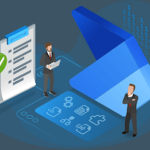Over the decades, small businesses have relied on intuition, past statistics, and instinct to make critical decisions. Although the traditional means offered a certain degree of direction, it was not always accurate, resulting in significant mistakes. The introduction of AI in predictive analytics represents a paradigm shift that has altered the approach organizations take to decision-making.
Statista reported that 55% of marketers segment and target their audience with the help of AI. This clearly mentions how companies use advanced analytics and remain competitive. Likewise, organizations in all industries are investing in using AI-powered analytics to identify key patterns, predict trends, and provide smarter insights.
Here in this blog, we will discuss how AI in business analytics is transforming guesswork into AI-driven data-backed decisions, which industries are benefiting the most, and how you can start.
Role of AI in Predictive Analytics
The traditional predictive models could not handle data sets and multifaceted variables. This is where AI for predictive insight is of invaluable importance. Using machine learning (ML) and deep learning (DL), AI increases the level, precision, and scale of predictions.
You will get to know how AI improves predictive analytics:
- Increased Precision: AI and regression models optimize forecasts by processing the data of millions of variables at the same time.
- Real-Time Insights: AI can work with data streams in real-time, which is essential in industries like stock trading or logistics.
- Unstructured Data Processing: Starting with social media sentiment and all the way to IoT sensor data, AI can be used to provide a deeper understanding of the context.
- Adaptability: Models update their knowledge base with the addition of new data, making them smarter eventually.
Bringing AI into business analytics makes predictive models proactive. Organizations can confidently predict market behavior and customer personas for smarter decisions.
Key Benefits of AI in Predictive Analytics
The benefit of using AI for analytics brings a competitive edge in several aspects.
1. Improved Accuracy & Reliability
AI removes human bias and error to guarantee more accurate forecasting. To provide an example, AI-based banking fraud detection models have an accuracy rate of more than 95%.
2. Scalability
The traditional analytics tools cannot analyze terabytes of structured and unstructured data without performance problems, but AI is capable of doing so.
3. Automation
Data crunching was done manually earlier, but with AI models, you can automatically identify anomalies, trends, and opportunities.
4. Personalization
Influencer Marketing Hub reports that 41 percent of companies rely on AI to provide a personalized consumer experience. From product recommendations on Amazon and personalized playlists on Spotify, all are based on AI in customer behavior prediction, ensuring engagement.
5. Proactive Decision-Making
Predicting machine failures, ordering, or customer turnover, AI can assist organizations in taking action before issues get bigger.
Moving from reactive repairs to a proactive approach, companies can attain AI-driven data-backed decisions that eliminate risks and expand opportunities.
Industry Use Cases of AI-Powered Predictive Analytics
This section covers how different industry niches leverage AI predictive analytics use cases to optimize operations, enhance decision-making, and achieve new growth opportunities.
1. Healthcare
- Predicting disease outbreaks and patient rehospitalization.
- Individual treatment plans with AI in data analytics.
- Deep learning algorithms detect life-threatening conditions at an early stage.
2. Finance
- Predictive AI credit scoring.
- Real-time identification of fraudulent transactions.
- Trend forecasting of the stock market with the help of AI.
3. Retail & E-commerce
- Inventory management.
- Individual product suggestions based on AI in the behavior modeling of customers.
- Anticipate churn and keep valuable customers.
4. Manufacturing & Supply Chain
- Predictive maintenance to avoid expensive maintenance of machinery.
- AI in predictive analytics for supply-demand balancing.
- Optimization in logistics to minimize delivery delays.
5. Marketing & Sales
- Lead scoring and conversion probability.
- AI-powered analytics predict the performance of a campaign.
- Customer lifetime value prediction.
Future of AI in Predictive Analytics
The future of AI in predictive analytics is not only making smarter predictions but also providing organizations with the ability to act accurately and confidently in the moment. With the continued development of AI capabilities, predictive analytics will keep getting stronger to become not a passive prediction but a dynamic, adaptive, and prescriptive data-driven insight that will revolutionize all industries.
Here are some key directions
1. Prescriptive & Adaptive Analytics
Predictive models will become prescriptive models, which will not only inform businesses about what is likely to happen, but also suggest what can be done best to address the situation.
2. Integration with IoT & Edge Computing
As billions of IoT devices produce real-time data, AI in data analytics, combined with edge computing, will allow real-time predictions on the ground.
3. Hyper-Personalization
With the development of AI in the prediction of customer behavior, the brands will be in a position to make recommendations, offers, and services at an individual level in a hyper-personalized way.
4. Democratization of Analytics
Today, predictive analytics services usually require technical skills, though in the future, no-code and low-code technologies will be on the increase. This democratization will enable the marketing teams, sales managers, and leaders of operations to create and implement predictive models.
How Businesses Can Get Started
The move to integrate AI in predictive analytics may look challenging, yet with the appropriate roadmap, companies will be able to harness its power incrementally. It does not matter whether you are in the healthcare industry, finance, retail industry, or manufacturing; the strategy is to match technology adoption with business objectives.
1. Set Clear Objectives
Determine the problem you are trying to solve: is it AI predicting customer behavior to drive retention, or AI predicting trends to drive supply chains? Clear objectives make sure that predictive models produce quantifiable outcomes.
2. Prioritize Data Quality
Accurate forecasts require clean, correct, and impartial information. Data across various sources should be consolidated, inconsistencies should be eliminated, and presented to AI to gain predictive information.
3. Right Tools and Partners
Look at scalable AI-based analytics solutions that fit your budget and industry requirements. In case of limited expertise within the organization, it is a great strategy to consult the AI development services to shorten the time.
4. Build or Expand Your Team
Decide whether to educate the current team, onboard new talent, or hire AI developers. An internal strategy that is accompanied by outsourced technical expertise is a hybrid model that succeeds for many enterprises.
Challenges & Considerations
While the benefits of AI in predictive analytics are impressive, businesses must navigate several challenges before unlocking its full potential:
1. Data Quality Issues
The predictive models can only be as good as the data it has been trained. Poor datasets, incomplete or biased datasets, may also result in inaccurate predictions and wrong strategies.
2. Model Interpretability
A majority of the contemporary AI models, especially deep learning, are similar to black boxes, meaning they give results without a description. Decision-makers might find it impossible to rely on or implement such predictions without such a lack of transparency.
3. Ethical & Privacy Concerns
The use of sensitive data, particularly in AI to predict customer behavior, has some serious ethical and privacy issues. Such mishandling of personal information can lead to regulatory fines under any of the laws (GDPR or CCPA) or to a damaged reputation.
4. High Costs & Skills Gap
Implementing Predictive Insight for AI is an expensive procedure requiring infrastructure, tools, and talent. The AI engineers, data scientists, and analysts of emerging technologies like ML are in very high demand and are costly to recruit.
Wrapping Up
The shift from human-based decision-making processes to data-supported, AI-based decisions is a turning point in the history of the business. Predictive analytics with AI is enabling organizations to act with greater precision than ever before by revealing trend patterns, predicting customer trends, and reducing risks exponentially.
It could be AI in customer behavior prediction for personalized marketing or AI in trend prediction in finance; the businesses that embrace such technology now will be the leaders of tomorrow. It is high time to consider the services of AI development or hire AI developers who would be able to convert raw data into effective, action-oriented insights. With the adoption of AI-enabled analytics, companies can be sure that they are replacing guesswork with foresight and transforming the challenges presented to them into opportunities to propel desired growth.


